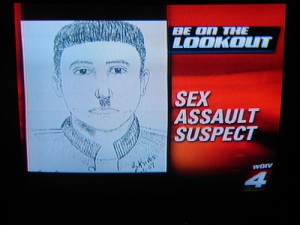How Accurately Do Police Sketches Depict Latinos?
 Years ago, when I anchored television news for a living, I would read the description of a criminal suspect-Latino male, mid-thirties, medium build, mustache-and think, “holy crap, that’s me!”…me and just about every other Latino in San Antonio.
Years ago, when I anchored television news for a living, I would read the description of a criminal suspect-Latino male, mid-thirties, medium build, mustache-and think, “holy crap, that’s me!”…me and just about every other Latino in San Antonio.
I found comfort in the fact that most of the times the cops had a sketch, drawn from witness descriptions, and I thought there’d be nuanced differences-bushy eyebrows, a scar on the lip-that would distinguish me form every other Latino suspect in the city.
I thought about that when I read this in the Philadelphia Enquirer:
When they were investigating the series of attacks on women in Kensington, police stopped dozens of black or Latino men who were thought to resemble a face in a forensic sketch.
When they finally caught the suspect the people in the neighborhood where the attacks happened said the sketch looked nothing like the guy the cops arrested. In the end it was DNA evidence that provided cause for an arrest. But the question lingers.
In repeated studies, psychologists have found that people are not very good at recalling a face after just one encounter. And accuracy is even worse if the witness has to describe a face so someone else can draw a picture – whether with a pencil or with one of various available computer programs.
That could be because witnesses are asked to describe specific facial features for a sketch artist-eyes,lips-ears, etc..-whereas the human brain, according to research, perceives a face as a composite whole. So the sketch becomes a thrown-together drawing of individual features, and not a specific face.
And then, of course, there are the stereotypical facial features that blend into a witness’s recollection.
Manuel Enrique Sanchez, one of the men police stopped during their investigation, saw no resemblance, nor did he think his own face was similar to either the suspect’s or the sketch. Except that all three were men of color wearing a hoodie – not an unusual sight in Kensington.
“Everyone fits that description,” Sanchez said.
In a study where people were shown a police sketch of a person they knew well only 9 percent identified the suspect. The rest could not identify the person in the drawing.
Still, (Philadelphia police sketch artist Roderick) Scratchard says, sketches have value. “The composite is not meant to be a portrait. It’s meant to be a characterization,” said the artist. “Just because one feature might be wrong doesn’t make the composite wrong.”
Here’s the dilemma: while the accuracy of police sketches may be questioned and may result in the detention or at the very least the questioning of otherwise innocent persons, sometimes it’s all the authorities have to go on.
Follow Victor Landa on Twitter: @Vlanda
[Photo by technochick]
